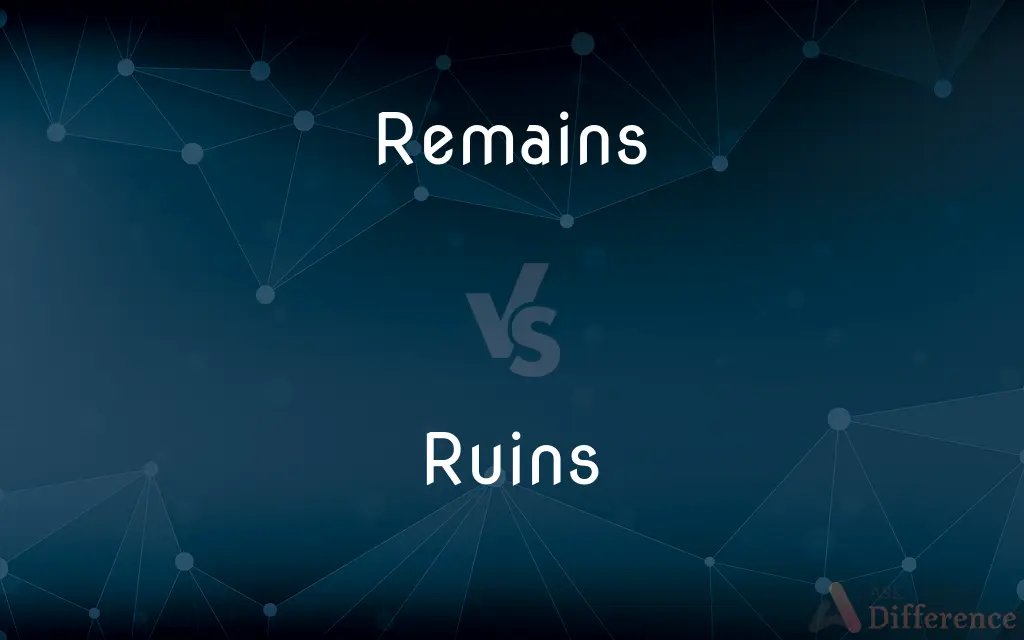Remains vs. Ruins — What's the Difference?
By Maham Liaqat & Fiza Rafique — Updated on March 28, 2024
Remains refer to what is left after other parts have been removed, used, or destroyed, whereas ruins are the remains of a structure that has been severely damaged or destroyed.

Difference Between Remains and Ruins
Table of Contents
ADVERTISEMENT
Key Differences
Remains encompass not just physical structures but also include any leftover parts from something that was once whole, highlighting the concept of what is left behind after a loss or consumption. On the other hand, ruins specifically refer to the remains of buildings, cities, or monuments that have suffered destruction, often conveying a sense of historical loss or decay.
While the term "remains" can be applied broadly across contexts including biological (e.g., skeletal remains), cultural, and even legal (e.g., estate remains), ruins are almost exclusively used to describe architectural and archeological sites, emphasizing their historical and cultural significance.
Remains might not always suggest a significant change in form or function from the original state, as it can simply imply what is left (e.g., food remains). Ruins, however, denote a substantial transformation, usually resulting from cataclysmic events or the passage of time, leading to a state of disrepair.
The study and exploration of remains can span various disciplines such as archaeology, forensics, and history, depending on the nature of what is left behind. In contrast, the study of ruins is primarily an archaeological and historical pursuit, focusing on understanding past civilizations, cultures, and architectural practices.
Interest in remains can be motivated by a desire to piece together incomplete pictures, whether it be the cause of a disaster, the lifestyle of a past civilization, or the circumstances leading to a person's demise. Conversely, interest in ruins often stems from their aesthetic and historical value, as they serve as tangible connections to the past and as subjects of artistic and literary inspiration.
ADVERTISEMENT
Comparison Chart
Definition
What is left after other parts have been removed or destroyed.
The remains of structures that have been severely damaged or destroyed.
Context
Broad, including biological, cultural, and legal aspects.
Primarily architectural and archaeological.
Connotation
Can imply partial loss or consumption.
Suggests significant destruction and decay.
Discipline
Varies (archaeology, forensics, history).
Archaeology, history.
Motivation for Interest
Understanding incomplete pictures, causes of events.
Historical, aesthetic value, connection to the past.
Compare with Definitions
Remains
Surviving evidence or artifacts of historical significance.
The museum houses remains of ancient pottery and tools.
Ruins
The remains of buildings, cities, or monuments that have suffered destruction.
The ruins of the ancient temple attracted historians from around the world.
Remains
Anything left behind or surviving.
The remains of the day offered a beautiful sunset.
Ruins
Ruins symbolize the passage of time and the fragility of human creations.
The castle ruins symbolize the inevitable decay of human endeavors.
Remains
The residue of an estate after debts and legacies have been satisfied.
The will detailed how the remains of the estate were to be distributed.
Ruins
Structures that carry historical or cultural importance due to their past.
The ruins stand as a reminder of the city's glorious past.
Remains
What is left of something that was once greater.
The archaeological remains suggest a once-thriving civilization.
Ruins
Ruins often attract attention due to their beauty and mystery.
Artists and poets have long been inspired by the haunting beauty of ruins.
Remains
The part left after the rest has been removed or used.
The remains of the meal were scattered across the table.
Ruins
Sites of ruins are key to understanding ancient civilizations.
The excavation of these ruins has provided insight into ancient architectural techniques.
Remains
What is left after a person (or any organism) dies; a corpse.
They buried the remains of their longtime friend in the town cemetery.
The victim's remains were one small piece of bone.
Ruins
Ruins (from Latin ruina 'a collapse') are the remains of a civilization's architecture: structures that were once intact have fallen, as time went by, into a state of partial or total disrepair, due to lack of maintenance or deliberate acts of destruction. Natural disaster, war and population decline are the most common root causes, with many structures becoming progressively derelict over time, due to long-term weathering and scavenging.
Remains
Historical or archaeological relics.
Ruins
The state of being physically destroyed, collapsed, or decayed
The castle fell into ruin.
Remains
The extant writings of a deceased person.
To his great intellectual powers his published remains bear abundant witness.
Ruins
The state of being extensively harmed or damaged
Our vacation plans are in ruins.
Remains
All that is left of the stock of some things; remnants.
He couldn't bring himself to eat the remains of the chicken dinner.
Ruins
Poverty of bankruptcy
Their decision brought the bank to ruin.
Remains
(rare) remain
Ruins
Often ruins A destroyed, collapsed, or decayed building or other physical entity
The ruins of the old mill.
Remains
Any object that is left unused or still extant;
I threw out the remains of my dinner
Ruins
One that has been extensively damaged or harmed
He is a ruin of his former self.
Ruins
A cause of destruction or irreparable harm or loss
Gambling will be his ruin.
Ruins
To cause (a building, for example) to be in a destroyed, collapsed, or decayed state.
Ruins
To harm or damage the quality or value of (something) irreparably
A bad diet ruined his health.
Ruins
To harm or damage the enjoyment or experience of (something) greatly
Ruined the movie by talking throughout it.
Ruined the book by giving away the ending.
Ruins
To reduce to poverty or bankruptcy
Bad loans ruined the banker.
Ruins
Plural of ruin
Common Curiosities
How do remains contribute to scientific research?
Remains, whether biological or cultural, can offer critical clues in various fields like forensics, archaeology, and history, helping to reconstruct past events or lifestyles.
Why are ruins significant in archaeology?
Ruins provide valuable insights into historical architecture, cultures, and civilizations, serving as direct links to the past.
Can the term "remains" be used interchangeably with "ruins"?
Not always; "remains" has a broader usage, while "ruins" specifically refers to architectural and archaeological remains.
What differentiates remains from ruins?
Remains refer broadly to what is left behind, covering various contexts, while ruins specifically denote the remains of structures that have been destroyed or severely damaged.
Do all ruins come from ancient times?
While many ruins are ancient, modern structures can also become ruins due to disasters or abandonment.
How does the interpretation of remains differ in forensics compared to archaeology?
In forensics, remains are analyzed to solve modern crimes or mysteries, while in archaeology, remains are studied to understand historical cultures and events.
What challenges are associated with preserving ruins?
Preserving ruins can be challenging due to environmental factors, funding limitations, and the need for specialized conservation techniques.
What can ruins tell us about past societies?
Ruins can reveal architectural styles, social hierarchies, and daily lives of past societies, offering a window into their worlds.
How do conservation efforts for ruins and remains differ?
Conservation of ruins often focuses on stabilization and public access, while remains might need more specialized preservation methods depending on their material and context.
Are ruins always considered valuable?
While ruins often hold historical and aesthetic value, perceptions of value can vary based on cultural, historical, and individual perspectives.
What role do ruins play in art and literature?
Ruins often serve as symbols of decay, historical continuity, or the sublime, inspiring artists and writers to reflect on themes of time, beauty, and destruction.
Can remains include objects besides buildings and structures?
Yes, remains can also include objects like artifacts, documents, and biological specimens, reflecting a wide range of contexts.
Can ruins affect local communities and tourism?
Yes, ruins can significantly impact local communities by attracting tourism, fostering cultural pride, and sometimes sparking debates on preservation.
Why might legal documents refer to "remains" of an estate?
Legal documents use "remains" to describe what is left of an estate after debts, taxes, and legacies have been settled, indicating the final portion to be distributed.
What ethical considerations arise in the excavation of ruins and remains?
Ethical considerations include respecting the cultural and historical significance of sites, avoiding exploitation, and ensuring proper handling and documentation of findings.
Share Your Discovery

Previous Comparison
Color vs. Paint
Next Comparison
Headteacher vs. PrincipalAuthor Spotlight
Written by
Maham LiaqatCo-written by
Fiza RafiqueFiza Rafique is a skilled content writer at AskDifference.com, where she meticulously refines and enhances written pieces. Drawing from her vast editorial expertise, Fiza ensures clarity, accuracy, and precision in every article. Passionate about language, she continually seeks to elevate the quality of content for readers worldwide.
















































